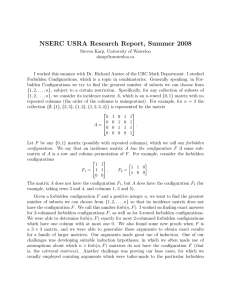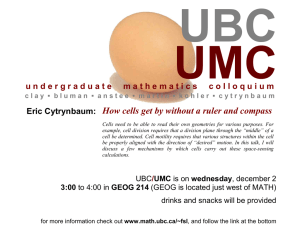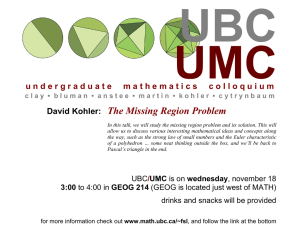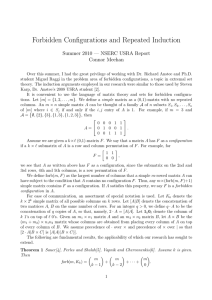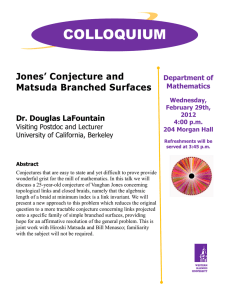Forbidden Configurations: Progress on a Conjecture Richard Anstee UBC, Vancouver
advertisement
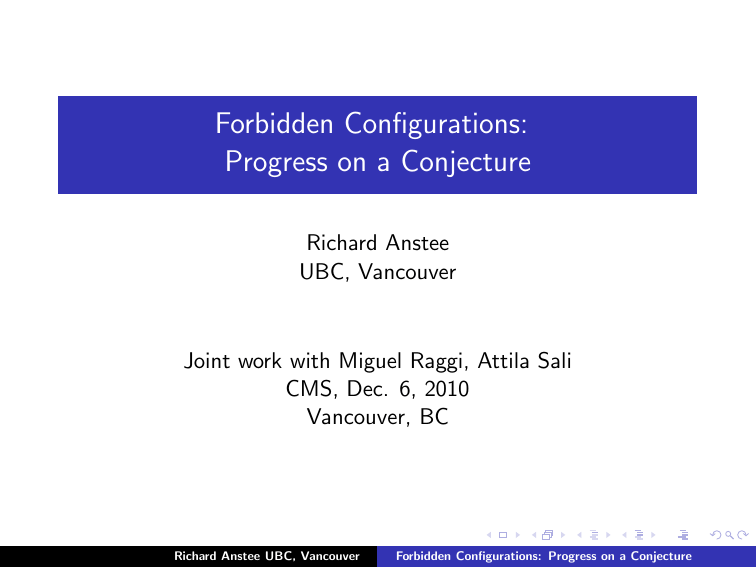
Forbidden Configurations:
Progress on a Conjecture
Richard Anstee
UBC, Vancouver
Joint work with Miguel Raggi, Attila Sali
CMS, Dec. 6, 2010
Vancouver, BC
Richard Anstee UBC, Vancouver
Forbidden Configurations: Progress on a Conjecture
Definition We say that a matrix A is simple if it is a (0,1)-matrix
with no repeated columns.
i.e. if A is m-rowed then A is the incidence
A of subsets of [m] = {1, 2, . . . , m}.
0 1 1 1 1
0 1 0 1 1
A=
0 0 0 0 1
0 1 1 0 0
matrix of some family
1
0
1
0
A = ∅, {1, 2, 4}, {1, 4}, {1, 2}, {1, 2, 3}, {1, 3}
Richard Anstee UBC, Vancouver
Forbidden Configurations: Progress on a Conjecture
Definition We say that a matrix A is simple if it is a (0,1)-matrix
with no repeated columns.
i.e. if A is m-rowed then A is the incidence
A of subsets of [m] = {1, 2, . . . , m}.
0 1 1 1 1
0 1 0 1 1
A=
0 0 0 0 1
0 1 1 0 0
matrix of some family
1
0
1
0
A = ∅, {1, 2, 4}, {1, 4}, {1, 2}, {1, 2, 3}, {1, 3}
Definition We define |A| to be the number of columns in A.
|A| = 6
Richard Anstee UBC, Vancouver
Forbidden Configurations: Progress on a Conjecture
Definition Given a matrix F , we say that A has F as a
configuration if there is a submatrix of A which is a row and
column permutation of F .
0 1 1 1 1 1
0 1 0 1 1 0
0 0 1 1
F =
∈ A=
0 0 0 0 1 1
0 1 0 1
0 1 1 0 0 0
Richard Anstee UBC, Vancouver
Forbidden Configurations: Progress on a Conjecture
Definition Given a matrix F , we say that A has F as a
configuration if there is a submatrix of A which is a row and
column permutation of F .
0 1 1 1 1 1
0 1 0 1 1 0
0 0 1 1
F =
∈ A=
0 0 0 0 1 1
0 1 0 1
0 1 1 0 0 0
We consider the property of forbidding a configuration F in A for
which we say F is a forbidden configuration in A.
Definition Let
forb(m, F )= max{|A| : A m-rowed simple, no configuration F }
Thus if A is any m × (forb(m, F ) + 1) simple matrix then A
contains the configuration F .
Richard Anstee UBC, Vancouver
Forbidden Configurations: Progress on a Conjecture
Definition Given a matrix F , we say that A has F as a
configuration if there is a submatrix of A which is a row and
column permutation of F .
0 1 1 1 1 1
0 1 0 1 1 0
0 0 1 1
F =
∈ A=
0 0 0 0 1 1
0 1 0 1
0 1 1 0 0 0
We consider the property of forbidding a configuration F in A for
which we say F is a forbidden configuration in A.
Definition Let
forb(m, F )= max{|A| : A m-rowed simple, no configuration F }
Thus if A is any m × (forb(m, F ) + 1) simple matrix then A
contains the configuration F .
1 0
For example, forb(m,
) = m + 1.
0 1
Richard Anstee UBC, Vancouver
Forbidden Configurations: Progress on a Conjecture
Definition Let Kk denote the k × 2k simple matrix of all possible
columns on k rows.
Theorem (Sauer 72, Perles and Shelah 72, Vapnik and
Chervonenkis 71)
m
m
m
which is Θ(m k−1 )
+· · ·+
+
forb(m, Kk ) =
0
k −2
k −1
Richard Anstee UBC, Vancouver
Forbidden Configurations: Progress on a Conjecture
Definition Let Kk denote the k × 2k simple matrix of all possible
columns on k rows.
Theorem (Sauer 72, Perles and Shelah 72, Vapnik and
Chervonenkis 71)
m
m
m
which is Θ(m k−1 )
+· · ·+
+
forb(m, Kk ) =
0
k −2
k −1
Corollary Let F be a k × ` simple matrix. Then
forb(m, F ) = O(m k−1 )
Richard Anstee UBC, Vancouver
Forbidden Configurations: Progress on a Conjecture
Definition Let Kk denote the k × 2k simple matrix of all possible
columns on k rows.
Theorem (Sauer 72, Perles and Shelah 72, Vapnik and
Chervonenkis 71)
m
m
m
which is Θ(m k−1 )
+· · ·+
+
forb(m, Kk ) =
0
k −2
k −1
Corollary Let F be a k × ` simple matrix. Then
forb(m, F ) = O(m k−1 )
Theorem (Füredi 83). Let F be a k × ` matrix. Then
forb(m, F ) = O(m k )
Richard Anstee UBC, Vancouver
Forbidden Configurations: Progress on a Conjecture
A Product Construction
The building blocks of our product constructions are I , I c and
1 1 1
0 1 1 1
1 0 0 0
0 1 0 0
1
0
1
1
c
0 1 1
I4 =
0 0 1 0 , I 4 = 1 1 0 1 , T 4 = 0 0 1
0 0 0
1 1 1 0
0 0 0 1
Note that
1
∈
/ I,
1
0
∈
/ Ic,
0
T:
1
1
1
1
1 0
∈
/T
0 1
Richard Anstee UBC, Vancouver
Forbidden Configurations: Progress on a Conjecture
Definition Given an m1 × n1 matrix A and a m2 × n2 matrix B we
define the product A × B as the (m1 + m2 ) × (n1 n2 ) matrix
consisting of all n1 n2 possible columns formed from placing a
column of A on top of a column of B. If A, B are simple, then
A × B is simple. (A, Griggs, Sali 97)
1 1 1 0 0 0 0 0 0
0 0 0 1 1 1 0 0 0
1 0 0
1 1 1
0 0 0 0 0 0 1 1 1
0 1 0 × 0 1 1 =
1 1 1 1 1 1 1 1 1
0 0 1
0 0 1
0 1 1 0 1 1 0 1 1
0 0 1 0 0 1 0 0 1
Given p simple matrices A1 , A2 , . . . , Ap , each of size m/p × m/p,
the p-fold product A1 × A2 × · · · × Ap is a simple matrix of size
m × (mp /p p ) i.e. Θ(m p ) columns.
Richard Anstee UBC, Vancouver
Forbidden Configurations: Progress on a Conjecture
Definition Given an m1 × n1 matrix A and a m2 × n2 matrix B we
define the product A × B as the (m1 + m2 ) × (n1 n2 ) matrix
consisting of all n1 n2 possible columns formed from placing a
column of A on top of a column of B. If A, B are simple, then
A × B is simple. (A, Griggs, Sali 97)
1 1 1 0 0 0 0 0 0
0 0 0 1 1 1 0 0 0
1 0 0
1 1 1
0 0 0 0 0 0 1 1 1
0 1 0 × 0 1 1 =
1 1 1 1 1 1 1 1 1
0 0 1
0 0 1
0 1 1 0 1 1 0 1 1
0 0 1 0 0 1 0 0 1
Given p simple matrices A1 , A2 , . . . , Ap , each of size m/p × m/p,
the p-fold product A1 × A2 × · · · × Ap is a simple matrix of size
m × (mp /p p ) i.e. Θ(m p ) columns.
Richard Anstee UBC, Vancouver
Forbidden Configurations: Progress on a Conjecture
Examples
[01] × [01] = K2
k
z
}|
{
[01] × [01] × · · · × [01] = Kk
1
0
I2 × I 2 =
1
0
1
0
0
1
0
1
1
0
0
1
≈ C4
0
1
Im/2 × Im/2 is vertex-edge incidence matrix of K m/2,m/2
Richard Anstee UBC, Vancouver
Forbidden Configurations: Progress on a Conjecture
The Conjecture
We conjecture that our product constructions with the three
building blocks {I , I c , T } determine the asymptotically best
constructions.
Richard Anstee UBC, Vancouver
Forbidden Configurations: Progress on a Conjecture
The Conjecture
We conjecture that our product constructions with the three
building blocks {I , I c , T } determine the asymptotically best
constructions.
Definition Let x(F ) denote the largest p such that there is a
p-fold product which does not contain F as a configuration where
the p-fold product is A1 × A2 × · · · × Ap where each
c ,T
Ai ∈ {Im/p , Im/p
m/p }.
Conjecture (A, Sali 05) forb(m, F ) is Θ(m x(F ) ).
Richard Anstee UBC, Vancouver
Forbidden Configurations: Progress on a Conjecture
The Conjecture
We conjecture that our product constructions with the three
building blocks {I , I c , T } determine the asymptotically best
constructions.
Definition Let x(F ) denote the largest p such that there is a
p-fold product which does not contain F as a configuration where
the p-fold product is A1 × A2 × · · · × Ap where each
c ,T
Ai ∈ {Im/p , Im/p
m/p }.
Conjecture (A, Sali 05) forb(m, F ) is Θ(m x(F ) ).
The conjecture has been verified for k × ` F where k = 2 (A,
Griggs, Sali 97) and k = 3 (A, Sali 05) and l = 2 (A, Keevash 06)
and for k-rowed F with bounds Θ(m k−1 ) or Θ(mk ) (A, Fleming
10) plus other cases.
Richard Anstee UBC, Vancouver
Forbidden Configurations: Progress on a Conjecture
In order for a 4-rowed F to have forb(m, F ) be quadratic in m, the
associated simple matrix must have a quadratic bound. Using a
result of A and Fleming, there are three simple column-maximal
4-rowed F for which forb(m, F ) is quadratic. Here is one example:
1 0 1 0 1 0
0 1 0 1 0 1
F8 =
0 0 1 1 1 1
0 0 1 1 0 0
How can we repeat columns in F8 and still have a quadratic bound?
We note that repeating either the column of sum 1 or the column
of sum 3 will result in a cubic lower bound. Thus we only consider
taking multiple copies of the columns of sum 2.
Richard Anstee UBC, Vancouver
Forbidden Configurations: Progress on a Conjecture
In order for a 4-rowed F to have forb(m, F ) be quadratic in m, the
associated simple matrix must have a quadratic bound. Using a
result of A and Fleming, there are three simple column-maximal
4-rowed F for which forb(m, F ) is quadratic. Here is one example:
1 0 1 0 1 0
0 1 0 1 0 1
F8 =
0 0 1 1 1 1
0 0 1 1 0 0
How can we repeat columns in F8 and still have a quadratic bound?
We note that repeating either the column of sum 1 or the column
of sum 3 will result in a cubic lower bound. Thus we only consider
taking multiple copies of the columns of sum 2. For a fixed t, let
1 0
1 0 1 0
0 1 0 1 0 1
F8 (t) =
0 0 1 1 t · 1 1
0 0
0 0 1 1
Richard Anstee UBC, Vancouver
Forbidden Configurations: Progress on a Conjecture
1
0
F8 (t) =
0
0
0
1
0
0
1
0
1
1
1
0
1 0
t·
1 1
0
1
0
1
1
0
Theorem (A, Raggi, Sali 09) Let t be given. Then forb(m, F 8 (t))
is O(m2 ). Moreover F8 (t) is a boundary case, namely for any
column α not already present t times in F 8 (t), then
forb(m, [F8 (t)|α]) is Ω(m 3 ).
The proof is currently a rather complicated induction with some
directed graph arguments. For each α there are Ω(m 3 ) product
constructions avoiding [F8 (t)|α].
Richard Anstee UBC, Vancouver
Forbidden Configurations: Progress on a Conjecture
1
0
F8 (t) =
0
0
0
1
0
0
1
0
1
1
1
0
1 0
t·
1 1
0
1
0
1
1
0
Theorem (A, Raggi, Sali 09) Let t be given. Then forb(m, F 8 (t))
is O(m2 ). Moreover F8 (t) is a boundary case, namely for any
column α not already present t times in F 8 (t), then
forb(m, [F8 (t)|α]) is Ω(m 3 ).
The proof is currently a rather complicated induction with some
directed graph arguments. For each α there are Ω(m 3 ) product
constructions avoiding [F8 (t)|α].
There are two other 4-rowed F to consider which should have
quadratic bounds. This would verify the conjecture for k = 4.
Richard Anstee UBC, Vancouver
Forbidden Configurations: Progress on a Conjecture
Let
1
1
F (t) = t ·
0
0
0
1
0 1
=
1 0
1
0
···
···
···
···
1
1
0
0
0
0
1
1
···
···
···
···
0
0
1
1
Problem Let t be given. Show that forb(m, F (t)) is O(m 2 ).
Richard Anstee UBC, Vancouver
Forbidden Configurations: Progress on a Conjecture
Let
1
1
F (t) = t ·
0
0
0
1
0 1
=
1 0
1
0
···
···
···
···
1
1
0
0
0
0
1
1
···
···
···
···
0
0
1
1
Problem Let t be given. Show that forb(m, F (t)) is O(m 2 ).
The above is true for both t = 1 and t = 2. The above problem
follows from the general conjecture. Solving this problem would no
doubt enable the proof of quadratic bounds for the two other
4-rowed F
Richard Anstee UBC, Vancouver
Forbidden Configurations: Progress on a Conjecture
5 × 6 Simple Configuration with Quadratic bound
The Conjecture predicts nine 5-rowed simple matrices F which are
boundary cases, namely forb(m, F ) is O(m 2 ) and for any column α
we have forb(m, [F |α]) being Ω(m 3 ). Such F happen all to be
5 × 6 simple matrices and we have handled the following case.
1 1 0 1 1 0
1 0 1 1 1 1
0
1
0
1
0
1
F7 =
0 0 1 0 0 1
0 0 0 0 1 0
Theorem (A, Raggi, Sali) forb(m, F7 ) is O(m2 ).
The proof is currently a rather complicated induction.
Richard Anstee UBC, Vancouver
Forbidden Configurations: Progress on a Conjecture
Induction
Let A be an m × forb(m, F7 ) simple matrix with no configuration
F7 . We can select a row r and reorder rows and columns to obtain
row r
0 ··· 0 1 ··· 1
A=
.
Br
Cr Cr
Dr
Now [Br Cr Dr ] is an (m − 1)-rowed simple matrix with no
configuration F7 . Also Cr is an (m − 1)-rowed simple matrix with
no configurations in F where F is derived from F 7 .
Then |A| = forb(m, F ) ≤ forb(m − 1, F ) + |C r |.
To show |A| is quadratic it would suffice to show |C r | is linear for
some choice of r .
Richard Anstee UBC, Vancouver
Forbidden Configurations: Progress on a Conjecture
Repeated Induction
Let Cr be an (m − 1)-rowed simple matrix with no configuration in
F. We can select a row s and reorder rows and columns to obtain
row s 0 · · · 0 1 · · · 1
Cr =
.
Es
Gs Gs
Hs
To show |Cr | is linear it would suffice to show |Gs | is bounded by a
constant for some choice of s. Our proof shows that assuming
|Gs | > 8 for all choices s results in a contradiction.
This repeated induction is used to show that forb(m, F 7 ) is O(m2 ).
Richard Anstee UBC, Vancouver
Forbidden Configurations: Progress on a Conjecture
An unusual Bound
Theorem (A,Raggi,Sali) forb(m, {T 2 × T2 , T2 × I2 , I2 × I2 }) is
Θ(m3/2 ).
1
0
T2 × T 2 =
1
0
1
0
1
1
1
1
1
0
1 1
1
0 0
1
, T × I2 =
1 0
1 2
0 1
1
1
0
I2 × I 2 =
1
0
Richard Anstee UBC, Vancouver
1
0
0
1
0
1
1
0
1
1
1
0
1
1
,
0
1
0
1
0
1
Forbidden Configurations: Progress on a Conjecture
Induction
Let A be an m × forb(m, F) simple matrix with no configuration in
F. We can select a row r and reorder rows and columns to obtain
row r
0 ··· 0 1 ··· 1
A=
.
Br
Cr Cr
Dr
To show |A| is O(m 3/2 ) it would suffice to show |Cr | is O(m1/2 )
for some choice of r . Our proof shows that assuming
|Cr | > 16m1/2 for all choices r results in a contradiction.
Richard Anstee UBC, Vancouver
Forbidden Configurations: Progress on a Conjecture
1 0
,
I2 =
0 1
1 1
T2 =
0 1
Definition For an m-rowed matrix P, we define f (F , P) =
max{|A| : A an m − rowed submatrix of P, no configuration F }.
For example, with Km denoting the m × 2m simple matrix, then
forb(m, F ) = f (F , Km ).
Richard Anstee UBC, Vancouver
Forbidden Configurations: Progress on a Conjecture
1 0
,
I2 =
0 1
1 1
T2 =
0 1
Definition For an m-rowed matrix P, we define f (F , P) =
max{|A| : A an m − rowed submatrix of P, no configuration F }.
For example, with Km denoting the m × 2m simple matrix, then
forb(m, F ) = f (F , Km ).
Theorem (A,Raggi,Sali) f (T2 × T2 , Tm/2 × Tm/2 ) is Θ(m).
Theorem (A,Raggi,Sali) f (I2 × T2 , Im/2 × Tm/2 ) is Θ(m).
Theorem (A,Raggi,Sali) f (I2 × I2 , Im/2 × Im/2 ) is Θ(m3/2 ).
The first result follows from the Marcus and Tardos (05) results on
forbidden patterns.
Richard Anstee UBC, Vancouver
Forbidden Configurations: Progress on a Conjecture
1 0
,
I2 =
0 1
1 1
T2 =
0 1
Definition For an m-rowed matrix P, we define f (F , P) =
max{|A| : A an m − rowed submatrix of P, no configuration F }.
For example, with Km denoting the m × 2m simple matrix, then
forb(m, F ) = f (F , Km ).
Theorem (A,Raggi,Sali) f (T2 × T2 , Tm/2 × Tm/2 ) is Θ(m).
Theorem (A,Raggi,Sali) f (I2 × T2 , Im/2 × Tm/2 ) is Θ(m).
Theorem (A,Raggi,Sali) f (I2 × I2 , Im/2 × Im/2 ) is Θ(m3/2 ).
The first result follows from the Marcus and Tardos (05) results on
forbidden patterns. The second follows from a proof related to the
result of Marcus and Tardos.
Richard Anstee UBC, Vancouver
Forbidden Configurations: Progress on a Conjecture
1 0
,
I2 =
0 1
1 1
T2 =
0 1
Definition For an m-rowed matrix P, we define f (F , P) =
max{|A| : A an m − rowed submatrix of P, no configuration F }.
For example, with Km denoting the m × 2m simple matrix, then
forb(m, F ) = f (F , Km ).
Theorem (A,Raggi,Sali) f (T2 × T2 , Tm/2 × Tm/2 ) is Θ(m).
Theorem (A,Raggi,Sali) f (I2 × T2 , Im/2 × Tm/2 ) is Θ(m).
Theorem (A,Raggi,Sali) f (I2 × I2 , Im/2 × Im/2 ) is Θ(m3/2 ).
The first result follows from the Marcus and Tardos (05) results on
forbidden patterns. The second follows from a proof related to the
result of Marcus and Tardos. The third result is quite different
from the conjecture and relates to Kovari, Sos, Turan (54).
Richard Anstee UBC, Vancouver
Forbidden Configurations: Progress on a Conjecture
The same proof techniques will show
Theorem f (Tk × Tk , Tm/2 × Tm/2 ) is O(m)
Theorem f (I3 × T3 , Im/2 × Tm/2 ) is O(m)
Richard Anstee UBC, Vancouver
Forbidden Configurations: Progress on a Conjecture
The same proof techniques will show
Theorem f (Tk × Tk , Tm/2 × Tm/2 ) is O(m)
Theorem f (I3 × T3 , Im/2 × Tm/2 ) is O(m)
Problem Can you show f (I4 × T4 , Im/2 × Tm/2 ) is O(m)?
Richard Anstee UBC, Vancouver
Forbidden Configurations: Progress on a Conjecture
THANKS to the session organizers! Hope you have enjoyed
Vancouver.
Richard Anstee UBC, Vancouver
Forbidden Configurations: Progress on a Conjecture

